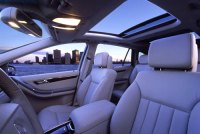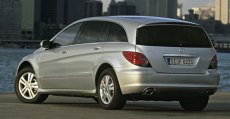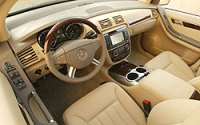|
 Crossover,
everybody talks crossover these days. Mercedes-Benz is no exception.
After A-class and CLS-class, it is pushing the concept of crossover
vehicles to new height with the R-class. Crossover,
everybody talks crossover these days. Mercedes-Benz is no exception.
After A-class and CLS-class, it is pushing the concept of crossover
vehicles to new height with the R-class.
The
R-class is something between estate car, MPV and SUV. Its exterior
design looks as if a crossover between estate and MPV, being bigger
than the former and sleeker than the latter. It offers 6 seats in 3
rows, plus very generous passenger and cargo room, so that it can
compete with conventional MPVs. However, the relatively less playing kits and high loading floor
works more like estate cars. Moreover, the R-class has a compulsory
4-wheel-drive system and high ground clearance to enable some offroad
ability. Therefore it is also an alternative to SUVs.
 You might find all these sounds
familiar. Yes, Chrysler Pacifica already has all such attributes. In
fact, the two cars were developed by the same team of Mercedes-Benz
engineers (of course, Chrysler's engineers also involved the American
car). But it is not to say they were sister cars. In fact, their
similarity is mainly in concept rather than sharing components. The
only common component is the E-class-derived 5-link rear suspensions,
but the version adopted by R-class has more aluminum components for
lower unsprung weight, hence smoother ride. It also gets the Airmatic
DC adaptive damping and air springing which the cheaper Chrysler
doesn't. Apart from that, both cars share little components - they have
their own engines, different transmissions (the R-class employs the
latest 7G-Tronic while the Chrysler still rely on the previous 5-speed
automatic), different front suspensions (R-class has double wishbones
while Pacifica uses cheaper MacPherson struts) and of course, the
Mercedes is equipped with many luxurious features and safety equipment
that the Chrysler cannot dream of. You might find all these sounds
familiar. Yes, Chrysler Pacifica already has all such attributes. In
fact, the two cars were developed by the same team of Mercedes-Benz
engineers (of course, Chrysler's engineers also involved the American
car). But it is not to say they were sister cars. In fact, their
similarity is mainly in concept rather than sharing components. The
only common component is the E-class-derived 5-link rear suspensions,
but the version adopted by R-class has more aluminum components for
lower unsprung weight, hence smoother ride. It also gets the Airmatic
DC adaptive damping and air springing which the cheaper Chrysler
doesn't. Apart from that, both cars share little components - they have
their own engines, different transmissions (the R-class employs the
latest 7G-Tronic while the Chrysler still rely on the previous 5-speed
automatic), different front suspensions (R-class has double wishbones
while Pacifica uses cheaper MacPherson struts) and of course, the
Mercedes is equipped with many luxurious features and safety equipment
that the Chrysler cannot dream of.
 The
4WD systems are also
different. The R-class system uses a regular center differential to
split 50% torque to both axles in normal conditions. Because the
differential does not have any limited slip function, it uses the
hardware of ABS to lock the slipping wheels in critical conditions
(i.e. when one axle slip, the computer will apply braking to the wheels
of that axle so that more torque will be transferred to the other
axle). This sounds quite cheap, but the Pacifica's system is even
cheaper - it uses viscous-coupling to transfer torque to the rear
wheels in case of slippery. This means it is only a part-time 4WD. The
4WD systems are also
different. The R-class system uses a regular center differential to
split 50% torque to both axles in normal conditions. Because the
differential does not have any limited slip function, it uses the
hardware of ABS to lock the slipping wheels in critical conditions
(i.e. when one axle slip, the computer will apply braking to the wheels
of that axle so that more torque will be transferred to the other
axle). This sounds quite cheap, but the Pacifica's system is even
cheaper - it uses viscous-coupling to transfer torque to the rear
wheels in case of slippery. This means it is only a part-time 4WD.
In fact, the
R-class
is a closer sister to the new ML-class SUV instead. They are both
produced in Mercedes' plant in Alabama, USA. Naturally, they share
engines, transmissions, suspensions and the 4WD system. (haha, sorry
for wasting your time in the above paragraphs - ed)
At 5.16 meters long, 1.92 meters wide and 1.66 meters tall, the R-class
is by all means a jumbo vehicle. Its 3215 mm wheelbase is even longer
than a long-wheelbase S-class ! in addition to the high roof, no wonder
the cabin feels significantly more spacious than the S-class !
 The negative side is weight.
The R-class tips the scale at almost 2.2 tons. This means R350's
272-horsepower 3.5-litre V6 is no where as firebreathing as in the C
and E-class. Luckily, it is mated with a 7-speed automatic gearbox,
otherwise performance would have been sluggish. R500's long-serving
306-horsepower 5.0 V8 is a little quicker, but our hope is placed on
the forthcoming 32-valve 5.5-litre V8, which will add another 60
horsepower. Of course, AMG's new 6.3 V8 will top the range next year
with 510 horsepower. By then maybe it would become the world's first
estate / MPV / SUV / Sportscar crossover ? The negative side is weight.
The R-class tips the scale at almost 2.2 tons. This means R350's
272-horsepower 3.5-litre V6 is no where as firebreathing as in the C
and E-class. Luckily, it is mated with a 7-speed automatic gearbox,
otherwise performance would have been sluggish. R500's long-serving
306-horsepower 5.0 V8 is a little quicker, but our hope is placed on
the forthcoming 32-valve 5.5-litre V8, which will add another 60
horsepower. Of course, AMG's new 6.3 V8 will top the range next year
with 510 horsepower. By then maybe it would become the world's first
estate / MPV / SUV / Sportscar crossover ?
Back
to the cabin. Naturally, the first 2 rows are very roomy, especially
because the second row is also a pair of independent chairs. However,
the most shocking is that the third row can accommodate adults of 6' 2"
tall, sitting behind occupants of the same height. The only thing the
third row passengers need to tolerate is shoulder room, as the seat is
recessed between the rear wheels. Like SUVs, the seats are mounted
higher than regular cars to give the occupants a commanding view. This,
accompany with large windows and panoramic glass roof, makes the cabin
bright and airy.
 Compare to other recent
Mercedes, the dashboard styling is conservative while the build quality
is slightly off the standard of German-built Mercedes. Nevertheless,
the leather seats are comfortable, the chassis feels solid and the
noise insulation is remarkable, therefore this cabin is still a first
class environment. One thing really distinguish the R-class from
Chrysler Pacifica and others is market positioning. This can be
revealed in its price (start from an eye-popping US$50,000 for R350 and
US$65,000 for a fully-loaded R500) as well as the luxurious
environment. For example, you can have a pair of LCD entertainment
system installed behind the front backrest for the second row
passengers. Therefore R-class is also an alternative to luxurious cars. Compare to other recent
Mercedes, the dashboard styling is conservative while the build quality
is slightly off the standard of German-built Mercedes. Nevertheless,
the leather seats are comfortable, the chassis feels solid and the
noise insulation is remarkable, therefore this cabin is still a first
class environment. One thing really distinguish the R-class from
Chrysler Pacifica and others is market positioning. This can be
revealed in its price (start from an eye-popping US$50,000 for R350 and
US$65,000 for a fully-loaded R500) as well as the luxurious
environment. For example, you can have a pair of LCD entertainment
system installed behind the front backrest for the second row
passengers. Therefore R-class is also an alternative to luxurious cars.
How does it drive? currently, only American version has been tested.
Predictably, its high-profile tires and soft-set suspensions bias
towards the comfort side. In addition to the ultra-long wheelbase, the
R-class rides superbly smooth. Does this mean the handling suffer ? Not
really. Mercedes is always a Mercedes. No matter how comfortable it
biased, it always ensure a good level of handling. (The same cannot
said to Japanese cars) This is why it has Airmatic DC. If you switch
the air suspensions to Sport mode, it will stiffen the springing and
damping to keep body roll in check, resulting in a rather nimble
handling character. Of course, this is still a very big, tall and heavy
car thus you cannot compare it with the S-class, but by MPV and SUV
standard it is easily one of the best.
Strangely, the R-class is the world's first luxurious MPVs, although
Mercedes and BMW have been planning such cars for a decade and a half.
Why does it take so long to realize ? I guess the relatively less
demand for such cars does not justify the cost of building a standalone
platform. That's why Mercedes had to wait until the redesign of
ML-class to share platform. Will BMW follow its footprints with a
X5-derived people carrier ? We shall see.
European R-class
The R-class' main market is in the United States. For European market,
a shorter R-class will be offered to suit the narrower and twistier
roads.
Its length will slip into the 5-meters barrier (at 4922 mm), with a
shorter wheelbase as well. As a result, the full-size rearmost seats
will become child seats only. To deliver sportier handling that
European customers prefer, the suspensions will have thicker anti-roll
bars and the steering rack will be retuned to deliver more feedback.
Besides, the European car will have a choice of 224 hp 3.2-litre
common-rail V6 turbo diesel, in the badge of R320CDI. |